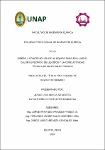Diseño y construcción de un equipo para evaluar el calor específico de líquidos y la conductividad térmica de materiales sólidos

Date
2024Author
Arista Sifuentes, Jorge Luis
Flores Babilonia, Liz Katherin Keyxi
Metadata
Show full item recordAbstract
The general objective of this thesis was to design and build a device to evaluate the specific heat of liquids and the thermal conductivity of solid materials. The device is composed of the following components: a stainless steel parallelepiped box, an electric heater as the heat source, and the following digital instruments: a temperature controller with a thermocouple sensor, an infrared digital thermometer, a metal probe thermometer, and a voltage and amperage meter. The liquids used had a mass of 0.2 kg and included: aguaje juice (with 12 % dissolved solids) and sugar solutions at: 10 %, 25 % and 40 % by weight. The specific heat values obtained were: 3889.80 J/(kg.°C), 3928.24 J/(kg. °C), 3592.21 J/(kg.°C) y 3530.92 J/(kg.°C), respectively. This indicated that the higher the concentration of dissolved solids, the lower the corresponding specific heat, demonstrating an inverse relationship between these two variables. The solids tested were: screw pine wood, marupa wood, wheat flour, brown sugar, and white sand, resulting in thermal conductivity values of: 00.19 W/(m.°C), 0.14 W/(m.°C), 0.12 W/(m.°C), 0.15 W/(m.°C) y 0.16 W/(m.°C), respectively. This indicated that wheat flour and screw pine wood are the solids with the lowest and highest heat conduction capabilities, respectively. Thus, this thesis has been completed, achieving the general objective and testing the general hypothesis. El objetivo general del presente trabajo de tesis fue: diseñar y construir un equipo para evaluar el calor específico de líquidos y la conductividad térmica de materiales sólidos, el cual está conformado por los siguientes componentes: una caja de acero inoxidable en forma de paralelepípedo, una resistencia eléctrica como fuente de calentamiento y los siguientes instrumentos digitales: un controlador de temperatura con sensor tipo termocupla, un termómetro digital infrarrojo, un termómetro con espiga de metal y un medidor de voltaje y amperaje. Los líquidos que se utilizaron tuvieron una masa de 0.2 kg, los cuales fueron: jugo de aguaje (con 12 % de sólidos disueltos) y soluciones azucaradas al 10 %, 25 % y 40 % en peso, de quienes resultó el calor específico: 3889.80 J/(kg.°C), 3928.24 J/(kg.°C), 3592.21 J/(kg.°C) y 3530.92 J/(kg. °C), respectivamente; lo cual indicó que cuanto mayor es la cantidad de sólidos disueltos, menor es el calor específico correspondiente; por lo tanto, esto demuestra que existe una relación inversa entre estas dos variables. Los sólidos que se utilizaron fueron: madera tornillo, madera marupa, harina de trigo, azúcar rubia y arena blanca, resultando la conductividad térmica para los mismos: 0.19 W/(m.°C), 0.14 W/(m.°C), 0.12 W/(m.°C), 0.15 W/(m.°C) y 0.16 W/(m.°C), respectivamente; lo cual indicó, que la harina de trigo y la madera tornillo, son los sólidos con menor y mayor capacidad para conducir el calor, respectivamente. De esta manera se ha culminado la presente tesis, cumpliéndose con el objetivo general y a la vez probándose la hipótesis general.
Collections
- Tesis [200]

